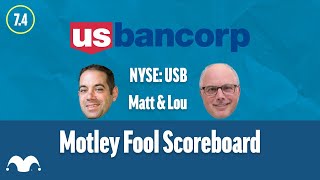Investors can darn near set their clock to US Bancorp's (USB +1.07%) earnings. With its most recent figures out this morning, the nation's largest regional lender proved yet again that slow and steady wins the race.
How US Bancorp won again
In what's becoming a trend for the bank industry, US Bancorp reported near record profits for the fourth quarter of 2012. In the three months ended Dec. 31, the lending giant earned $1.42 billion, a hair under the $1.47 billion that it made in the third quarter but still 5% higher on a year-over-year basis. For the entire year, moreover, its net income came in at $5.6 billion, a 15.9% increase compared to 2011.
According to CEO Richard Davis: "2012 was a great year for our Company, as we achieved record annual earnings of $5.6 billion, or $2.84 per diluted common share. Further, our 2012 full-year results included record total net revenue of $20.3 billion, representing growth in net interest income and fee revenues, as well as controlled expenses. "
While many analysts remain concerned over headwinds in the financial industry, we're seeing little evidence of struggle in the bottom-line figures of the nation's biggest banks. Among others, JPMorgan Chase (JPM +1.01%) and Wells Fargo (WFC +1.99%) both reported record earnings for the fourth quarter and 2012 fiscal year -- click here to read about JPMorgan's earnings and here for Wells Fargo's.
In JPMorgan's case, the nation's largest bank by assets earned a staggering $21.3 billion in net income despite writing off $6.2 billion for trading losses related to the London Whale scandal. And Wells Fargo earned $18.9 billion last year as the nation's largest mortgage originator continues to tighten its grip on the home-lending market.
For US Bancorp's part, it too is seeing gains on many of the same fronts. Its loans and deposits grew last quarter by 6.4% and 9.2%, respectively, on a year-over-year basis. In addition, its credit quality, never as big of an issue at US Bancorp as it was at many of its competitors, continues to improve. In the fourth quarter, both its net charge-offs of bad loans and its provisions for future loan losses came down.
According to the company's press release: "Our customers -- from individuals, to small businesses, to large corporations -- are healthy and productive, having adjusted to the current slow growth, uncertain environment in which they operate today, but they remain poised to take advantage of the recovery as it emerges."
The one bone of contention concerns US Bancorp's net interest margin -- that is, the difference between a bank's yield on earning assets and its cost of funds. This is one of the most important metrics in the banking industry because it dictates a large portion of a bank's revenue.
During the fourth quarter, US Bancorp saw this figure decline by four basis points sequentially and five points compared to the same quarter in 2011. This is notably better than the 10-basis-point decrease experienced by Wells Fargo, though it's not as good as, say, M&T Bank (MTB +1.27%), which reported today a three-basis-point sequential decline in the fourth quarter of 2012 but a 14-point year-over-year gain.
One of the reasons for this decline is paradoxically a harbinger of better earnings to come. Just like in Wells Fargo's case, it was spurred by deposit growth that outpaced loan growth. Because this increases the cost of funds relative to the income on earning assets, it necessarily drives the net interest margin down. Over the long run, however, these deposits will pay off in spades as the business environment improves and lending picks up additional steam.
The Foolish bottom line
All in all, US Bancorp finished off an exceedingly successful fourth quarter and 2012 fiscal year. And while its shares trade for a dear 2.6 times tangible book value, the likelihood of substantial dividend hikes in the future will secure US Bancorp's place among the best dividend stocks for income investors to own.









